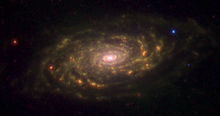Sunflower Galaxy
| Messier 63 | |
|---|---|
 M63 from GALEX sky survey | |
| Observation data (J2000 epoch) | |
| Constellation | Canes Venatici |
| Right ascension | 13h 15m 49.3s[1] |
| Declination | +42° 01′ 45″[1] |
| Redshift | 484 km/s[1] |
| Distance | 27 Mly[2] |
| Apparent magnitude (V) | 9.3[1] |
| Characteristics | |
| Type | SA(rs)bc[1] |
| Apparent size (V) | 12′.6 × 7′.2[1] |
| Other designations | |
| M63, NGC 5055, UGC 8334, PGC 46153[1] | |
Messier 63 (also known as M63, NGC 5055, or the Sunflower Galaxy) is a spiral galaxy in the constellation Canes Venatici consisting of a central disc surrounded by many short spiral arm segments, the galaxy form known as flocculent. M63 is part of the M51 Group, a group of galaxies that also includes M51 (the 'Whirlpool Galaxy'). M63 is an active galaxy with a LINER nucleus.[3] The existence of a super massive black hole (SMBH) at the nucleus is uncertain; if it does exist, then the mass is estimated as (8.5±1.9)×108 M☉.[4]
History
M63 was discovered by Pierre Méchain on June 14, 1779.[5] The galaxy was then listed by Charles Messier as object 63 in the Messier Catalogue.
In the mid-19th century, Lord Rosse identified spiral structures within the galaxy, making this one of the first galaxies in which such structure was identified.[5]
In 1971, a supernova with a magnitude of 11.8 appeared in one of the arms of M63.
.jpg)

References
- 1 2 3 4 5 6 7 "NASA/IPAC Extragalactic Database". Results for NGC 5055. Retrieved 2006-10-10.
- ↑ NASA (2015). . Retrieved Mar. 2, 2017
- ↑ "M 63". SIMBAD. Centre de données astronomiques de Strasbourg. Retrieved 16 November 2015.
- ↑ Graham, Alister W. (November 2008), "Populating the Galaxy Velocity Dispersion - Supermassive Black Hole Mass Diagram: A Catalogue of (Mbh, σ) Values", Publications of the Astronomical Society of Australia, 25 (4): 167–175, arXiv:0807.2549, Bibcode:2008PASA...25..167G, doi:10.1071/AS08013.
- 1 2 K. G. Jones (1991). Messier's Nebulae and Star Clusters (2nd ed.). Cambridge: Cambridge University Press. ISBN 0-521-37079-5.
External links
| Wikimedia Commons has media related to Sunflower Galaxy. |
- The Sunflower Galaxy on WikiSky: DSS2, SDSS, GALEX, IRAS, Hydrogen α, X-Ray, Astrophoto, Sky Map, Articles and images
- Sunflower Galaxy @ SEDS Messier pages
- Sunflower Galaxy (M63) at Constellation Guide
